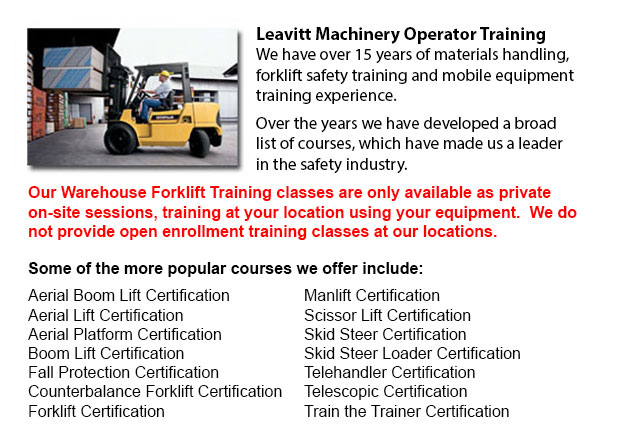
Toronto Warehouse Forklift Training Programs - Warehouses can either be industrial, commercial or retail facilities, functioning from bulk product retailing to product distribution services. Regardless of the type of warehouse, staff inside warehouse settings should be well trained in safety procedures related to material handling and storage, conveyor systems, loading docks, and forklifts and pallet jacks. Good housekeeping is vital to an orderly and safe warehouse setting.
Truck and loading dock systems are usually located at a height from the ground. Products enter and exit warehouses through these systems where employees unload and load materials from elevated docks and ramps. Particular attention should be paid to safety habits during this stage. To prevent falls, install yellow striping along the edge of ramps and docks. Pay attention to the area all-around delivery trucks which are parked at the loading dock, specifically the area between dock and the truck. Be sure that truck wheels are chocked while unloading.
Some warehouses use conveyor systems to distribute products inside the facility. Conveyor systems have moving wheels and belts that pose a pinch point danger. Keep body parts and hair well away from conveyors to prevent injury. Elevated conveyors pose a danger to personnel below if safety nets are absent. Staff need to know how to stop conveyors in case of emergency. Be aware of the location of off switches and emergency stop buttons. When servicing conveyors, tag out/lock out procedures are mandatory.
Forklifts and pallet jacks are designed to move materials all-around the warehouse. Forklift operators are required to take training and be given certification. Pallet jack operators do not require certification, but should be trained on the equipment. Training courses instruct operators in the right methods for hoisting things and transporting them to their assigned location. Neither forklifts nor pallet jacks should ever be used to lift or transport personnel.
Storage shelving and rack systems help to create an efficient and orderly work area if they are sturdy, braced, and allow sufficient room for people and machinery to pass. Slow and careful placement of good is required to prevent accidents caused by products falling off the facing aisle. Aisles should be kept clear by storing products flat and in the shelving units. Pallets are made use of for stacking products. They should be in good condition, and palleted products should be shrink-wrapped or baled, whenever possible.
Personal protective equipment (or also known as PPE) should be worn, as appropriate, to protect employees' limbs, heads, hands and feet. Hard hats or bump caps, gloves and steel-toed shoes are common PPE.
Slippery floors pocked with pits and dents present a hazard. Good housekeeping practices include keeping warehouse docks and floors clear of debris, oil and dirt. The area must be kept clear of trash, boxes and baling materials.
-
Toronto Wheel Loader Training
Toronto Wheel Loader Training - Normally, the different kinds of heavy equipment training are classed into 2 categories of machinery: those that have rubber tires and tracked vehicles. Tracked vehicles consist of items like for example excavators, cr... More -
Toronto Heavy Equipment Operator Training
Toronto Heavy Equipment Operator Training - Heavy equipment operator training facilities that provide good standards in the business, providing field performance tasks and added machinery training are really sought after training features. Students a... More -
Toronto Manlift Operator Certification
Toronto Manlift Operator Certification - We provide an aerial lift and scissor platform certification and training to empower the trainee with the general understanding and knowledge of the safe and efficient use of "Power Operated Mobile Work Platfo... More -
Toronto Aerial Boom Lift Ticket
Toronto Aerial Boom Lift Ticket - Aerial lifts can be utilized to accomplish a lot of unique duties done in hard to reach aerial spaces. Some of the odd jobs associated with this type of jack include performing regular preservation on structures with... More -
Toronto Heavy Equipment License
Toronto Heavy Equipment License - Obtaining a heavy equipment license is mandatory in order to operate these big industrial machinery. Certification could be acquired through a vocational school or private training. The license would enable the drive... More -
Skid Steer Loader Training in Toronto
A skid-steer loader is an engine powered equipment which consists of a small and rigid frame. It is outfitted together with lift arms that are utilized to connect to a large variety of labor saving tools and attachments. Typically, skid-steer loaders... More -
Toronto Aerial Lift Certification
Toronto Aerial Lift Certification - Aerial Lift Certification is for individuals who requires an in-depth understanding of aerial lift safety. Inspectors and operators, supervisors, maintenance workers and construction craftsmen should perform a cert... More -
Toronto Boom Lift Training
Toronto Boom Lift Training - Elevated work platforms, also called aerial platforms, allow workers to carry out tasks at heights which would otherwise be not reachable. There are different kinds of lifts intended for various site conditions and applic... More

Forklift Certification Toronto
TOLL FREE: 1-888-254-6157
Toronto, Ontario
forkliftcertificationtoronto.com
Email Us
About Us


